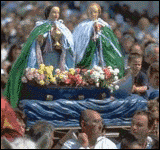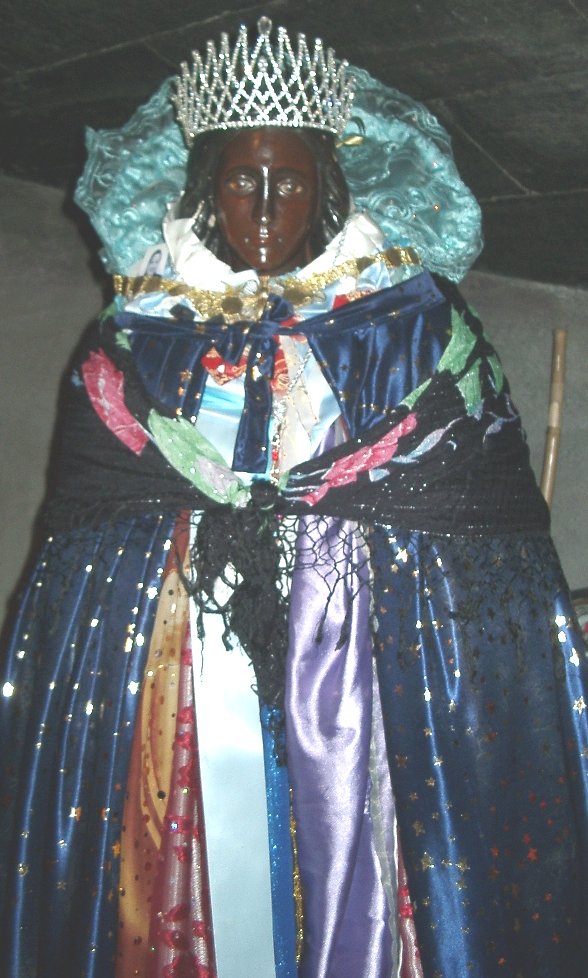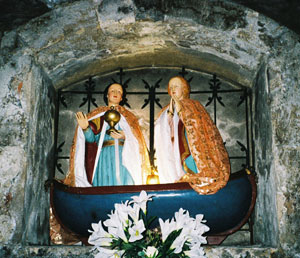Â
 Margaret Starbird wrote:
Margaret Starbird wrote:
May 23 is when the little town of Les Saintes-Maries-de-la-Mer begins to celebrate the festival of St. Sarah the Egyptian and the three Maries… (Mary Magdalene, Mary Jacobi and Mary Salomé) who allegedly arrived on the shore in “a boat with no oars” in c.AD 42…. apparently (according to French legend) bringing with them the Holy Grail and the “good news” of Christianity in their hearts (though it had yet to be written!)
The townspeople escort St. Sarah’s statue, dressed in seven layers of beautiful gowns created by tribes of Gypsy women, to the sea. Gypsy men on white horses carry the statue on a platform and stand in the waves while the crowd signs hymns and shouts “Vive Ste Sarah!”–
There are several suggestions as to why Sarah is black: she is “Egyptian” (i.e. born in Egypt), she is obscure (allegedly the maid-servant of the Maries, “just like Cinderella”) or, the one I consider most probably, she is a “hidden” offspring of the lineage of King David, whose heirs, “once white as milk, are now black as soot. They are not recognized in the streets” (Lamentations 4:7-8)… The bearers of that royal line are now political refugees in a foreign land…hoping to evade notice of the Romans who might seek to destroy them (as they did other relatives of Jesus in the first century). There is only one child on the boat in the French legends–and her name “Sarah” means “princess” in Hebrew.
Who do we say she is?
peace and light,
Margaret
* * * * * * * * * * * * * * * * * *
Professor Mary Ann Beavis posted in with this intriguing connection:
I say that she's Kali-Sarah, the christianized goddess of the Romany, originally from India (hence, the veneration of the dark goddess Kali).
Mary Ann
* * * * * * * * * * * * *
I then asked Margaret what legend is it where we see the little princess Sarah in the boat with no oars.
Scroll down below St Sarah’s picture and read Margaret’s answer…

* * * * * * * * * * * * * * * * * *
Hi, Katia,
Today, May 24, is Saint Sarah’s actual feast day.
The legends about St. Sarah stem from an long-standing oral tradition and have several variations. They were not available in any extant written form until after the Inquisition was securely entrenched in Southern France, so our chances of hearing the complete and unabridged story of St. Sarah are slim and none. Jacobus Voragine’s Golden Legend names “Marcelle” as the servant of Martha (Mary Magdalene’s sister), who travelled with the other refugees from Jerusalem in the boat with no oars. But at St. Maries de la Mer, this “serving girl” is called “St. Sarah”–based on legends apparently indigenous to the area. One late version of the story says that Sarah the Egyptian (also called Sarah the Black) was an gypsy queen who welcomed the refugees to France when they arrived, but since the gypsies themselves didn’t show up in Europe until the 14th century, that account can’t be the true version.
Wikipedia has a piece on St. Sarah here.
And here is the Golden Legend section on the topic.
and this blog entry called Celebrating with Saint Sarah has interesting info:
 Here’s my story (longer version is published in my “Goddess in the Gospels.” While my husband was the district engineer in Nashville, TN, we were invited to go out dinner with a group French mayors and their wives who were visiting. At the time, I was totally immersed in “Grail” research and found myself sitting next to a French woman who was the wife of one of the deputy mayors. I asked her about the early Christians on the shores of France and she lit up like a torch…. she had been to all the shrines of the Black Madonnas and to St. Maries de la Mer and knew all the “lore.” She told me about St. Sarah, and when I asked who she was, Madame Capolla told me that Sarah was “the little girl on the boat” with Mary Magdalene and Martha and Lazarus and the others who came from Jerusalem. When I got home I looked up “Sarah” in my concordance and discovered that it means “Princess.”
Here’s my story (longer version is published in my “Goddess in the Gospels.” While my husband was the district engineer in Nashville, TN, we were invited to go out dinner with a group French mayors and their wives who were visiting. At the time, I was totally immersed in “Grail” research and found myself sitting next to a French woman who was the wife of one of the deputy mayors. I asked her about the early Christians on the shores of France and she lit up like a torch…. she had been to all the shrines of the Black Madonnas and to St. Maries de la Mer and knew all the “lore.” She told me about St. Sarah, and when I asked who she was, Madame Capolla told me that Sarah was “the little girl on the boat” with Mary Magdalene and Martha and Lazarus and the others who came from Jerusalem. When I got home I looked up “Sarah” in my concordance and discovered that it means “Princess.”
Madame C. later mailed me several pamphlets and booklets from the shrines and Stes Maries, including pictures of St. Sarah dressed in her beautiful organdy and brocade dresses (piled on top of one another). The parallels with Cinderella (another princess from a far away land who is alleged to be the servant of her relatives) are obvious, along with the quote I provided from Lamentations about the faces of the heirs of King David, “now black as soot.”—
I personally think this story was so dangerous in the Middle Ages that it was couched in symbolism and told as a myth or legend. The “fossil” left for evidence is the title “Sarah” (princess) given to the child/servant (whom Voragine names “Marcelle”–but then, Voragine was a Roman Catholic bishop, so perhaps he was providing deliberate misinformation in his Magdalene story (most of which reads like pure fiction anyhow!).
peace and light,
Margaret
“The Woman with the Alabaster Jar”
www.margaretstarbird.net
Mary posted:
>….My research has told me that The Mothers of Arles Festival is held on the 24th ( from Juno Covella and The White Goddess) or this
> festival is celebrated from May 24-28th (The Grandmother of Time, Z. Budapest). I am curious to know how the 23rd of May fits in?
> Did you get this date from another text or have you visited Arles to see it taking place today?
________________
I have been to Les Saintes-Maries-da-la-Mer for the festival of Saint
Sarah and the “Maries” —which begins on the evening of the 23rd of
May with music and street dancing. Gypsies and tourists flock to the
town to celebrate the “vigil” of the festival. The 24th (today) is the
actual feast of St. Sarah, whose statue is kept in the crypt of the
basilica. A local bishop says high Mass in the basilica (“Our Lady of
the Sea”) in her honor, and then Sarah’s statue, bedecked in fabulous
finery, is taken from the church and escorted to the sea. Tomorrow (25
May) is the feast of the “Maries.” Their replica of two women with
covered chalices standing in a blue boat is lowered from it’s position
above the altar and is escorted to the sea, similar to the Sarah
parade and ceremony on the 24th. I’m not sure how this folk festival
ties in with other ancient “Goddess” celebrations, but I wouldn’t be
surprised if it did! Syncretism of ancient goddesses of love and
fertility abounds in the region: Isis, Juno, Cybele, Venus, Diana et alia.
peace and well-being,
Margaret
Margaret added:
Dear Katia,
After posting my last message about Jacobus Voragine, Archbishop of Genoa and author of the very pious but highly fictional “Golden Legend,” and the possibility that he was disseminating misinformation about “Marcelle,” the servant of Martha who voyaged with the refugees from Jerusalem, I discovered that Archbishop Jacobus Voragine was a Dominican. It was the Dominicans who established the Inquisition and hounded the Cathars and other heretics of the region in the 13th century, which only makes me more suspicious of his account of Mary Magdalene’s story.
I typed my earlier messages in a hurry—hope no one gets upset with my typos!! : )
Hope you are having a wonderful weekend! Freedom isn’t free (as my father used to remind us) and it’s worth fighting for….
peace and light,
Margaret
And still more from Margaret this time about the Gypsies…
Since the gypsies didn’t migrate from “Romany” to Southern France until the mid-fifteenth century, they cannot have been the original source of the “St Sarah the Egyptian” legends. St. Sarah’s remains were allegedly found with those of Maria Jacoby and Maria Salomé at Les Stes.-Maries-de-la-Mer and are housed in the 12th c. Basilica of “Our Lady of the Sea” in the center of the town. Sarah was called “Sarah the Egyptian”–which is why the Gypsies who encountered her in the Carmargue adopted her as their patron saint. The word “gypsy” is derived from Egypt; Europeans thought that the dark-skinned Romany were natives of Egypt and coined the name “gypsy” for them. — Apparently an earlier oral tradition included a young woman called
“Sarah the Egyptian” (born in Egypt) and was styled as a “servant” of Maria Jacoby and Maria Salomé (maybe because no one could think of a role for a child on the boat who was “born in Egypt”)… Having been trained to think in symbolic terms about these stories, and knowing the Scripture from Lamentations about the royal lineage of Israel having faces that are now “black as soot”– I suspected that this
child, whose name means “Princess”–might have been a daughter of Jesus and Mary Magdalene whose story was too dangerous to be told, so it was hidden in symbolic language. Just knowing that one of the earliest persons to record the legends of Mary Magdalene and her
friends arriving in Gaul was a 13th c. Dominican Archbishop is enough to make me suspicious that the “accepted” version of the story is not the true one–which is why I wrote the story that serves as the Prologue of “The Woman with the Alabaster Jar.”
peace and well-being,
Margaret
http://www.margaretstarbird.net
Jennifer Reif says on the importance of St Sarah:
To me, the importance of St Sarah is that as that she was the physical presence of the union of Mary Magdalene and Jesus. And as the fruit of their union, she continues to presents the affirmation of the Sacred Feminine in the Christian story, the Magdalene, the lost Christian Goddess. Sarah is the reminder that the loss of Jesus’ Bride, created an imbalance in the Catholic church as it clung to the distructive view of a ‘God-celebate-Jesus’ and a ‘mortal-prostitute-Magdalene.’ (Although her status as whore as been officially rescinded).
All of the misplaced and abusive sexuality, that even today’s Catholic church has participated in and tries to hide, remains the result of the removal of Mary Magdalene the Bride from the true story of Jesus’ life. The conventional insistance that Jesus never married will probably remain the reason that Catholic priests can’t marry, and may perhaps continue the tendacy for sexual abuse within the church.
So for me, Sara’s importance can’t be underestimated because she is the being, the daughter, the life, the evidence that Jesus and Mary Magdalene were wed and that what is both human and divine, can live and does live together in us all.
Love, Jennifer
The Holy Book of Mary Magdalene: The Path of the Grail Steward
http://www.amazon.com/exec/obidos/ASIN/0595522432/esoterictheologi
Jennifer Reif Author Website
http://www.demeter.spiritualitea.net/
As a Roman Catholic I would argue that feast of St. Sarah and its observance by French Catholics reflects an acknowledgement and affirmation of the divine feminine. The color of Sarah’s skin serves as a remiinder that powers that be within the Church attempted silence and duscredit those whose thought was non-conformist by branding them as heretical or otherwise schismatic.
I believe that in sense the festival served as a form of peaceful resistance by the Catholics of Languedoc whose pupose was an is to keep the pure unadulterated memory of the divine feminine alive within the hearts of Roman Catholics, as a counterbalance to the atempts made by the hierarchy to alter or otherwise adulterate the true nature of God to suit its purposes.
Saint Sarah serves as a beacon of hope for those Catholics within the Church whose voices have yet to be heard by Rome and it is by following the example set by her and her parents that on the Day of the Last Judgment we will able to say God that we were faithful to you,
In order to protect the heir of Christ, a servant was the only way to protect Sarah from harm.
Egypt is well known to be the place of safety of all Holy families. When arriving in France…They were safe. Sarah grow up in a rich envirnment full of love and hard work. She married a king and thus became the heirs which today walk the earth. Hope is here now! We are here! through family generation to generation we have kept quiet. I promise you this….God WINS! and those who “TRY” to distort the “FACTS” for their own “GAIN” and “CONTROL” will be delt with in GODS OWN TIME.
Date of birth and death? Canonized date? Why was Saint Sarah made a saint? Childhood Life? Patron saint of? Any other information? Thank You!!
http://www.statemaster.com/encyclopedia/Saint-Sarah
In actual fact AUGUST 19 is Saint Sara Feast Day.
The pilgrimmage to Sainte Maries de la Mer is during May 24 time frame, but Feast Day is August 19.
Saint Sarah’s feast day is 19th August. In France the official day of her pilgrimage is 24th May. Her statue is carried down to the sea on this day to reenact her arrival in France.
I read all your comments, my point is we don’t know. The book I believe in is the bible. Deep in my heart I want St. Sarah to be the lineage of David, and a gypsy – Roma people suffered too much over the centuries in Europe, the entire universe is a mix of all nationalities — God created one ADAM and one EVE at the beginning, so as human being we all are related but as sinners tying to aquire stutues, fame and discriminate one agains another. Some gypsies may be very well from Egypt, others from India… Look here in Canada, so many mixed marriages — later generations how would be able to know who is what…??? Anyway, I love my creater and Jesus Christ is my savior – I believe in everything that is in my bible and as I study more and more, I start to understand how little I actually know about myself, others and the world.
So thankful to have come upon your website!In late 60s I had a vivid out of body experience.Catapulted into a encampment of centuries past.The music was awesome as a beautiful,older Rom sang the most stirring words to the tribe surrounding her around the fire .Colors,nitescape scene.spectacular. She sang it over and over,I wittnesed,weeping and feeling combined sufferings,emotions of all.Got to piano and wrote lyrics/music,tried to find a group to sing it,not successful. sent it to vatican,asmibg cooperation to record ,use any profit to help the world’s Romani.The song was called Sarah,as she sang…Sarah,this is Sarah,gather. Round my Children of Rom…I never knew of her,but have always felt a Rom at heart,soul.May love and luck go with All,always and in all good ways!
I love the story of Mary Magdalene.. My forefathers pioneered here from France…a part of me in my soul feels like they were my ancestors… They called me crazy Mary all my life..Jesus came to me in several dreams n my son whom is 7years old now saw him….I am a descendant..no one can change that I am of French Indian descent born in America…. My soul spirit and heart believes I am an heir unto Mary Magdalene and Jesus offspring..French Indian descent raised in point-a-la-hache..so much genocide studies happened so many cover ups …the truth will out weigh time…..peace love and blessings unto all who is seeking for the truth…Jesus Christ is coming soon….everyone get ready..jamica barthelemy aka Mary Magdalene offspring….
Beautiful thank you!!! Dear Diane Simpao if you read this you can contact me..I’m a musician and actrice and have Roma friend, I think I can record and sing it for you! Would love to her this song from your dreams! i have been to Saint Marie la Mer many times!! Saint Sarah is my spiritual parent,,totally love her!!! carlavandersteen@kpnmail.nl